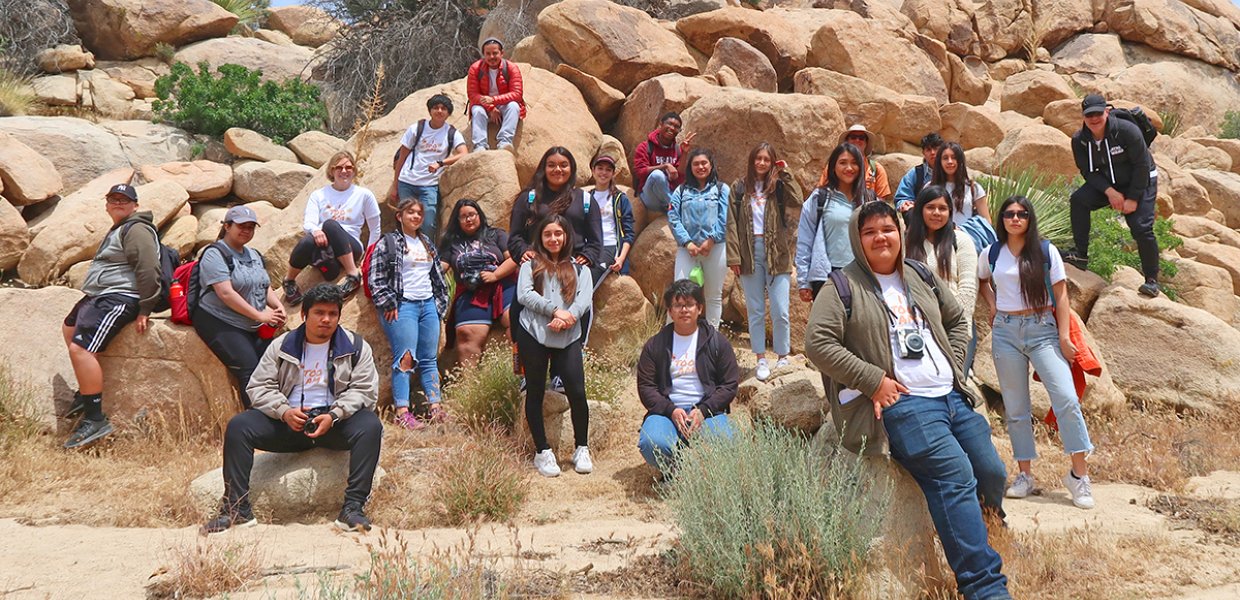Driving down Highway 62 on the way to Joshua Tree National Park, Francisco, one of the 20 high school students on the bus, noticed something different about the landscape. If he ever moved here, he told the group, he’d open up his own roadside taco stand, like the ones near his home in South Los Angeles. That way, he’d give people a taste of where he’s from.
During spring and early summer of this year, students from Bravo Medical Magnet High School near East Los Angeles and the Communication and Technology School in South Los Angeles took part in the “I Too Am: Teens, Media Arts, & Belonging” project. Alison Trope, clinical professor of communication and DJ Johnson, associate professor of practice from USC Cinema’s Media Arts + Practice Division, along with communication PhD student Olivia Gonzalez, designed the project, naming it after the iconic poem by Langston Hughes, “I, Too.” They hoped to use the poem as a way for students to contemplate questions of belonging and displacement in relation to their own identities.
“It was about getting high school students to tell their stories and to reflect on who they are and where they belong,” said Trope. “I too am a part of this community. I too am a part of Los Angeles. I too am part of California. I too am a part of America.”
With seed funds from RAP (Race, Arts, & Placemaking) and a grant from the USC Provost’s Arts and Action Initiative, “I Too Am” extends the work of Critical Media Project (CMP) — an interactive digital platform designed to teach media literacy and develop cultural competencies. “Through Critical Media Project, youth explore various categories of identity and their intersections through media representations,” Trope said. “For ‘I Too Am’ we took those themes and applied them to the concept of place. How does place shape who you are? Not only where you're from, but the places you visit — how does that influence who you can be and how you see yourself in the world?”
In addition to Joshua Tree, the students visited and learned about the history of several other iconic locations, including The Grove and Farmers Market, Will Rogers State Park and Manhattan Beach. The trips were designed to give youth the chance to learn critical and creative tools to think about the breadth of the city and its surrounding environs and share stories about their identity. Throughout each trip students had the chance to reflect on where they visited and address the question: “What is my story?” as it relates to place and identity. During the 40-minute drive to Will Rogers State Park, as the bus merged onto Sunset Boulevard and wound its way through Pacific Palisades, one student asked, “Is this the same Sunset that goes through our neighborhood?”
“This was about exploration, re-discovery, and creative practice,” Gonzalez, who is in her third year of the doctoral program, said. “Some of us were seeing these spaces for the first time. Some were seeing them in new ways. And all were encouraged to negotiate their relationship through creative practice — crafting things in a variety of mediums. Students constructed paper houses, took photographs and captured the sounds of the places they visited. They interviewed one another and people whom they met on the trips. They made videos, wrote poems and even built sandcastles.”
Students in the “I Too Am” project had the chance to tell their stories and reflect on who they are and where they belong. This short piece was voiced by one of the students and all the video and art was created by students in the various places they visited.
At the end of the project, students returned to USC for a culminating workshop to share their work and discuss what they had learned. “This project bolstered the students’ love for their community and appreciation for how it has shaped them,” Johnson said. “This project was about giving young people a chance to imagine how home and the things they learn there can be brought with them wherever they go.”
At the workshop, Cristina Ortega, from the Communication and Technology School, read her poem:
I too am.
I too am the people we look over on the streets.
I too am the beats we hum as music blast on the stereo.
I too am…
The barbeques at the park
The high school football games, the short walks to the liquor [store].
I too am proud of where I’m from.
I too am, South Central LA.
In the final interviews, many of the students remarked they had already made plans to take their families to the places they visited. For Trope, this was a desired next step. “The idea of carrying on this experience beyond just this one time was really important,” she said. “These young people have the right to these spaces just like anyone else.”
